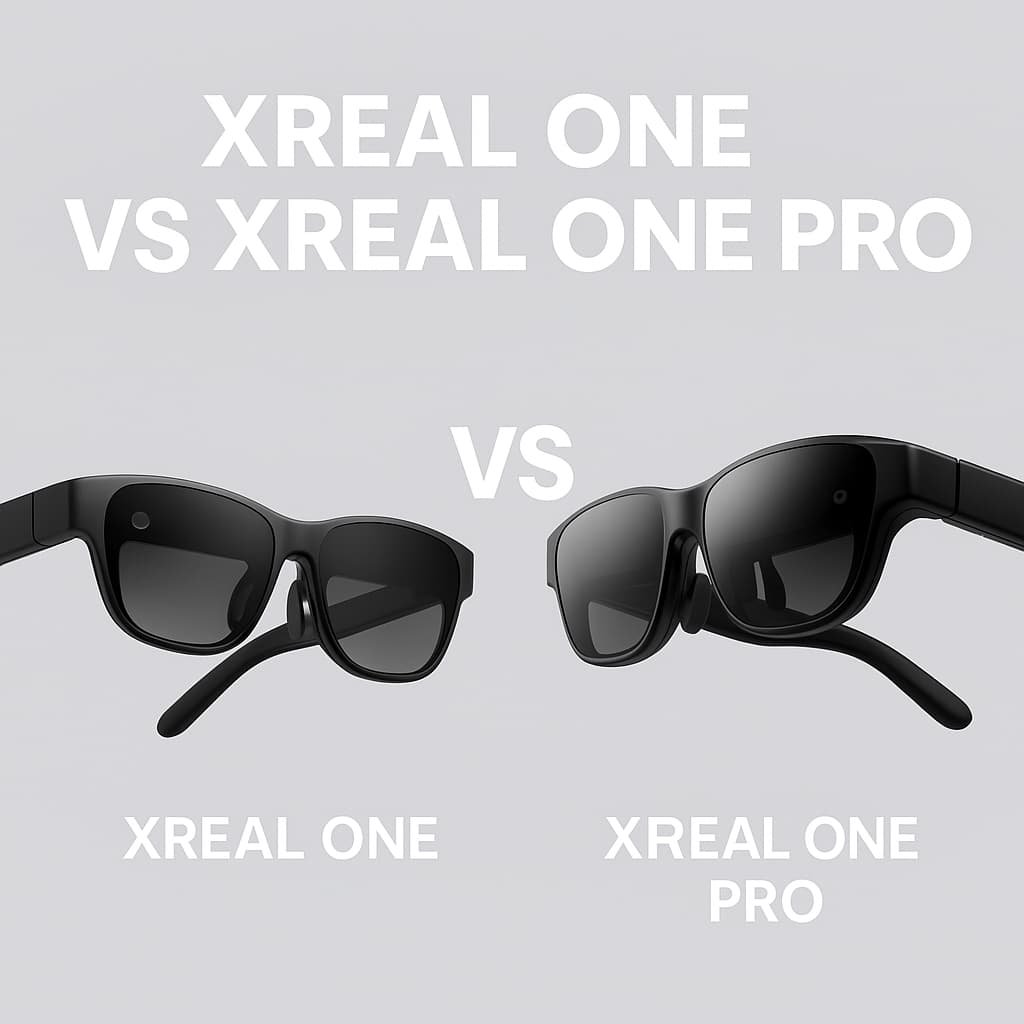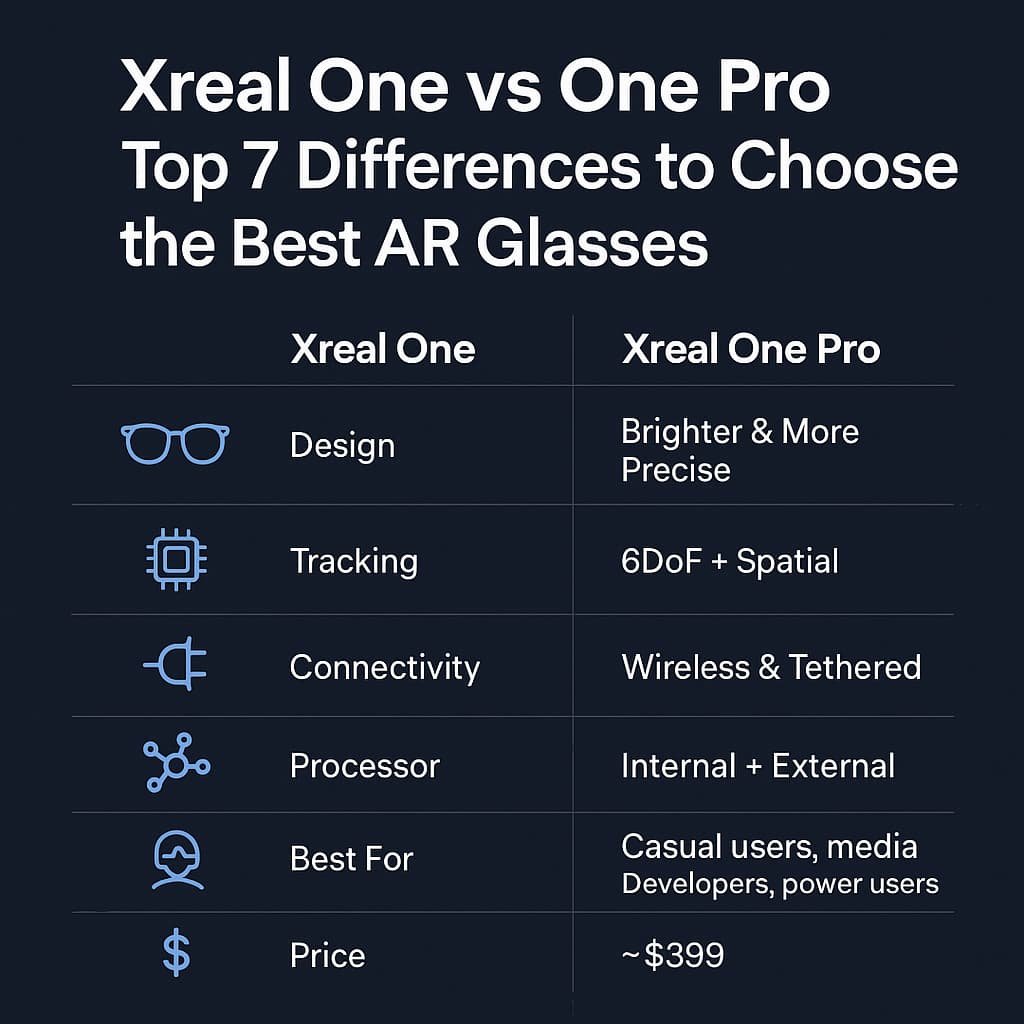Augmented Reality, or AR, is rapidly shaping the future of digital interaction, and Xreal (formerly Nreal) is at the forefront. Having recently launched the Xreal One Pro, users are now faced with a tough decision: Xreal One vs Xreal One Pro—which do you choose?

Whether you’re a general consumer who’s interested in mixed reality or a developer pushing AR to the extremes, knowing the difference between these two premium AR glasses matters. In this blog, we’ll break down the design, specs, performance, use cases, and pricing to enable you to decide between the Xreal One vs Xreal One Pro.
🕶️ Design and Comfort
Xreal One: Sleek and Lightweight
Xreal One AR glasses are designed with portability and comfort in mind. Weighing in at just roughly 80g, they feel very much like a standard pair of sunglasses. The Xreal One is perfect for long-term use without fatigue, with a bendy frame and soft nose pads.
Xreal One Pro: Premium Feel with a Bit More Heft
The Xreal One Pro, although sharing the same silhouette, is a bit more solidly built because of its higher-end internal hardware. Comfort remains best-in-class, though it’s a tad heavier. It’s also built more solidly and has a better hinge design for a more secure fit.
✅ Verdict: If featherlight wearability is your top priority, the Xreal One takes it. But for a premium feel and durability, go Pro.
📺 Display Technology and Visuals
They both have Micro-OLED displays with 1080p resolution per eye and a 46° field of view. But that’s where the Xreal One Pro takes a step forward.
Xreal One: Clear and Bright
The Xreal One has clear images and vivid colors. It can do up to 500 nits of brightness, so it’s suitable for indoor and partial shaded outdoor usage.

Xreal One Pro: Increased Visual Fidelity
The Pro bumps the brightness up to 600 nits, making it easier to see in outdoor settings. It also introduces pro-level color calibration and adaptive dimming for better contrast in variable lighting conditions.
✅ Verdict: In the Xreal One vs Xreal One Pro contest, the Pro wins out when it comes to display quality—especially for outdoor or creator applications.
⚙️ Performance and Processing Power
One of the biggest differences between the two is what’s happening under the hood.
Xreal One: Tethered Experience
The Xreal One must be connected to a compatible device (like a PC, phone, or Xreal’s Beam accessory) to function. It does not have onboard processing, relying entirely on external hardware.
Xreal One Pro: Standalone AR Power
The Xreal One Pro also features its own onboard processor, enabling semi-standalone functionality. It has Xreal’s NebulaOS, so it can already manage simple AR apps, stream media, and communicate with cloud services by itself—no phone and Beam required.
✅ Verdict: The Xreal One Pro wins the performance category with a stronger and more versatile AR experience.
🧠 Tracking and Sensors
Tracking is the heart of a seamless AR experience. Here’s how these two stack up:
Xreal One: Basic 3DoF Tracking
The Xreal One has 3 degrees of freedom (3DoF) head tracking. It’s fine for consuming content or basic AR overlays, but not ideal for immersive interactions.
Xreal One Pro: Full 6DoF + Spatial Awareness
Pro has 6DoF (6 Degrees of Freedom) tracking and also features improved sensors and spatial mapping. This enables you to move around in real-world space and interact with AR content more naturally.
✅ Verdict: Xreal One vs Xreal One Pro? The Pro is way more immersive and sophisticated.
🔌 Connectivity and Compatibility
Xreal One: Limited but Solid
The Xreal One gets along well with smartphones (Android especially), PCs, and gaming consoles via the Xreal Beam or USB-C direct connection. Its limiting factor is the lack of wireless functionality, however.
Xreal One Pro: Wireless Options Included
The Pro introduces Wi-Fi and Bluetooth connectivity, enabling wireless casting, cloud gaming, and screen mirroring without additional accessories. It also enables direct streaming from within apps.
✅ Verdict: If cord-cutting is important to you, go with the Pro.
👤 Use Cases: Who Are These Glasses For?
Xreal One: Perfect for Content Consumers and Gamers
If you’re wearing AR glasses just for Netflix watching, gaming through cloud streaming, or smartphone mirroring, the Xreal One is more than sufficient.
Xreal One Pro: Perfect for Developers and Power Users
The Pro is ideal for AR developers, productivity geeks, and anyone who wants a more independent, immersive AR experience. It works with custom apps and enterprise-level software.
✅ Verdict: For everyday use, the Xreal One is perfect. For next-level AR, the Pro is ideal.
🔋 Battery Life
Xreal One: No Battery
Since it doesn’t need internal processing, the Xreal One doesn’t include an internal battery—it’s powered by your connected device. That translates to long continuous use without needing to charge the glasses.
Xreal One Pro: Internal Battery
The Xreal One Pro includes an internal battery that will run for approximately 2–3 hours, depending on usage. It’s perfect for wireless AR experiences but adds the need for charging.
✅ Verdict: Tethered reliability (One) vs portable convenience (Pro).
💰 Value and Price
Xreal One: Affordable
At about $399, the Xreal One is excellent value for entertainment users.
Xreal One Pro: Premium Price
The Pro is about $699, with its independent capability, additional sensors, and better visuals.
✅ Verdict: For budget users, the Xreal One is a good value. For premium features and future-proofing, however, the Pro is worth the investment.
🛒 Where to Buy
Xreal One vs Xreal One Pro is a decision of more than specs—it’s a decision of just how deeply you’re ready to go into the augmented world. Whether you want to dip your toes in or explore new dimensions, Xreal has you covered.
🏁 Final Decision: Xreal One vs Xreal One Pro
To choose between Xreal One vs Xreal One Pro, make your decision depending on your use case for AR glasses:
| Feature | Xreal One | Xreal One Pro |
|---|---|---|
| Display | Excellent | Brighter & More Precise |
| Tracking | 3DoF | 6DoF + Spatial |
| Connectivity | Wired | Wireless & Tethered |
| Processor | External only | Internal + External |
| Best For | Casual users, media | Developers, power users |
| Price | ~$399 | ~$699 |
Choose the Xreal One if you require a lightweight, affordable AR headset for media and casual usage.
Choose the Xreal One Pro if you’re serious about AR, development, or immersive apps—and want a device that will grow with the ecosystem.